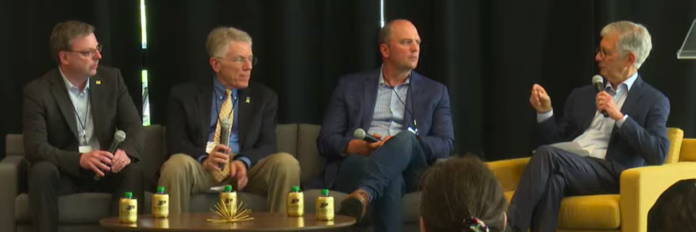How are some cities actually using IoT, new technologies and ever more sources of data? The mayors of three Indiana cities discussed their journeys with tech at a panel yesterday at an event highlighting Perdue University’s efforts to support and development various smart city-related technologies.
When Fishers, Indiana’s smart city journey began, it started with data, according to Mayor Scott Fadness. Four to five years ago, he said, “The technology was actually outpacing what our organization was capable of consuming.” Vendors were urging the city to put mobile/computing devices on everything, he said, but the city “didn’t have the organizational structure or the capacity to take that information and turn it into something meaningful for us.”
What Fishers realized, he went on, was that there were already thousands of existing data points within city government. At the time, he said, the city was probably running around 200 different software applications for various tasks, but without a holistic view or ability to collect data.
The city’s smart city work, then, didn’t start with connecting endpoints, he explained: It began with putting a data architecture in place for making informed decisions and focusing on “centers of data generation” including touchpoints such as human resources, finance, infrastructure, land use and law enforcement. But when it got to the point of putting that architecture in place, Fadness continued, it didn’t have the people it needed to make use of that architecture. So it hired a group of “business solutions” people who focus on data analytics, as well as working on software implementations.
“The biggest challenge was taking that group of people, with those tools, and convincing all of the other departments that the interactions with those individuals were of value,” he said.
In South Bend, Indiana, Mayor James Mueller said that, while under federal oversight due to sewer overflow violations, the city was able to use a sensor network in its sewers to re-negotiate the terms of an agreement with the EPA that will save city sewer customers more than $400 million as well as deliver better environmental outcomes. South Bend is also making use of an AI-based system that uses cameras on city vehicles to assess the state of its roads and rates each segment of road, to contribute data to the city’s prioritization of paving projects.
Mayor James Lienhoop of Columbus, Indiana, said that leveraging technology within existing systems enables better efficiency.
“We drive every mile, every inch of the city once a week,” he said. “So we’ve got eyes on the whole neighborhood.” Part of what the city wants to do, he went on, is to have a device mounted over a sanitation driver’s head that would allow him or her to push a button and drop a virtual “pin” indicating anything from a tree that needs attention, a pot hole or a car parked illegally, that send a message back to a central office so that someone can be dispatched to deal with it. That reduces the need to send out an entire crew to drive the city and look for those specific things: A crew checking out trees, a crew looking for potholes, and so on. “It gives us an opportunity to be much more focused,” he said. With the city workforce down about 5%, he added, it is considering things like automated mowers for sports fields, so that technology can help work to continue more efficiently i in the face of a personnel shortage.
Lienhoop also said that simple tech is helping the city both be more transparent and efficient at the same time. With many city projects going on around the town, he added, it’s very easy to put up a yard sign or placard with a QR code that asks passers-by “Would you like to know what’s going on here?” The QR code then links to a city website with information about the project, which he says cuts down on curious calls coming in to city hall.
“It just makes life a little bit easier as well as making us more productive,” he added. In addition, he said that infrared trailside sensors or sensors embedded in paved paths in the city’s 26-mile trail system are also telling the city bits of information such as whether a passerby is a pedestrian or bicycle rider, their speed and their direction of travel. This helps the city better understand where there are blind curves and how to better design its trails, he said.
Fadness said that technology can offer people the ability to solve problems in the moment, such as inspectors being able to fill out a form on a tablet in the field or look up information. From a larger view, however, “there are these very interesting questions of why, and the ability to answer them” that can be illuminated once the data is being collected. Fishers’ department of public works, he went on, now tracks every acre of grass that it mows each week—and it turns out that they mow around 1,200 acres of grass per week. “The simple question you can ask yourself is, why? Why do we have 1,200 acres of grass and does it make logical sense to spend taxpayer dollars mowing the same strip of grass over and over again, when you can plant it into some sort of native planting, and not have to mow 1,200 acres of grass?
“It’s the basic why questions,” he concluded. “But those were elusive, prior to having the data to understand that that was a question you should even ask.”

